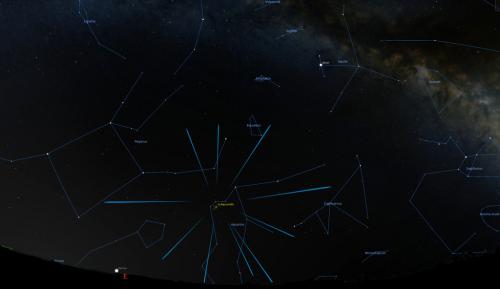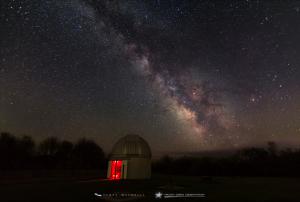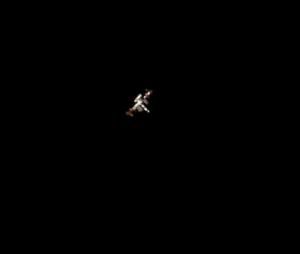Celebration of Space - Friday, May 3, 2024
This coming Saturday night – Sunday morning, May 4-5, 2024, the annual Eta Aquariid Meteor Shower peak will occur. The Eta Aquariids are usually a slow mover, and at Frosty Drew, we have historically been left out in the dew with little to no meteor activity from this peak. Though in 2024, the peak is forecast to be stronger than usual due to tidal interactions with Jupiter. Additionally, the Moon will not rise until 4:12 am, and only sport an 8% waning crescent, which is quite optimal for viewing the meteor shower. Unfortunately, the meteor display kicks in after 3:00 am, which is forecast to be under full cloud cover for our region, surprise! If you happen to find that you have clear sky conditions during the early morning hours on Sunday, be sure to head to a spot with minimal artificial light and a wide open view of the sky. Lay on your back with your feet oriented towards the south (earlier in the morning) or SW, and look to the zenith (top of the sky) to catch Eta Aquariid meteors streaking by. Additionally, the Eta Aquariids are known to produce blue fireball meteors, which will be brighter than your regular meteor. If you see one of these be sure to let us know.
Now that the Moon is largely departing the early morning sky, some of the best views of the Milky Way for the year are here. The New Moon will occur on May 7, 2024 at 11:24 pm ET, after which it will return to the early evening sky as a waxing crescent. This will give us a couple of weeks to catch up on early morning Milky Way viewing in Ninigret Park – home to Frosty Drew Observatory and Science Center, and one of the darkest spots in Southern New England. We feel that the saving grace of the slow moving Eta Aquariid Meteor Shower peak is the fantastic view of the Milky Way stretching across the sky in the morning hours. Even if you don’t see any meteors, the Milky Way will take your breath away.
The reason the Milky Way is so amazing to view during late April and early May is due to the times and locations that the Milky Way galactic nucleus is visible. In Ninigret Park, the best part of the sky to observe is the southern region, which is where the galactic nucleus will be visible. On May 8th, at 3:30 am, the galactic nucleus will be positioned due south with the plane of the galaxy stretching over the Observatory and across the sky towards the NNE. The plane will almost be as high as the zenith! At 3:30 am, many local sources of light pollution will not be active (actually, they should never be on, but that’s another story), and usually all the moisture in the air has condensed due to the overnight temp drop, and fallen as dew, which leaves the sky crystal clear.
At Frosty Drew, we always try to capture our yearly image of the Milky Way over the Observatory during this time, and it is certainly worth it. If deciding to visit Ninigret Park to observe, photograph, or just enjoy the Milky Way, be sure to be courteous of other visitors and do not enter the park with your high beam headlights on. In fact, traveling slowly with your daytime driving lights or marker lights will be the best way to do it. Once parked, immediately disable all lighting on your vehicle. It will take you about 15 minutes after viewing any light source, including your phone, to become fully adapted to the darkness, though once you are, the view will be amazing!
This past Wednesday, May 1, 2024 was May Day, a notable day for those looking to celebrate springtime. Even though May Day is often thought of with flower baskets and breakfasts, it is actually an astronomical event as it is a Cross-quarter Day. These days mark the midpoint between the Equinox and the Solstice, and reciprocally. Now that May Day has passed we are closer to the Summer Solstice than the Vernal Equinox. For those who love the summer heat and long daylight hours, you are in the last approach to awesome sauce. Other Cross-quarter Days are Lammas in August, Halloween in October, and Groundhog Day in February.
Now that we are closing in on the Summer Solstice in June, the daytime periods are getting longer with each passing day. As Earth continues its orbit towards the Summer Solstice, when the Northern Hemisphere is at maximum tilt towards the Sun, orbiting satellites are spending more time in direct sunlight over our region’s nighttime hours. This will allow for a significantly higher number of visible passes of the International Space Station (ISS) and Tiangong (China’s space station) over our region.
To visibly see the stations or other satellites pass by overhead, the satellite needs to be in direct sunlight while the observer on the ground is in darkness. The light you see from the orbiting satellite is not light emitted by the satellite, but instead sunlight reflecting off of the satellite. During the winter, all visible passes will happen in the hour after sunset or before sunrise, though during the start of summer, nearly all nighttime passes of a satellite will be visible. It takes the ISS and Tiangong 90 minutes to complete one full orbit around Earth, and over the next two-three months, nearly all of the nighttime passes will be visible. Right now the ISS is visible in the morning hours starting around 3:00 am. Though as this coming week progresses the ISS will continue to add additional visible passes with each passing night. On Friday, May 10th, the ISS will commence visible passes for every nighttime pass. On Thursday, May 9th, the ISS will return to the evening sky, while still being visible in the morning sky. Step outside at 9:25 pm on Thursday, and look to the SSW side of the sky to spot the ISS. The station will rise to 37º and into orbital sunset. Check in regularly with our prediction utility to see all the pass times visible for that day.
Now that the night is waning, get out and enjoy the late sunset, and the night sky.
- Author:
- Scott MacNeill
- Entry Date:
- May 3, 2024
- Published Under:
- Scott MacNeill's Columns





